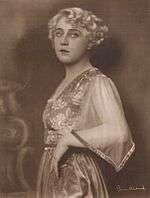Hedda Vernon
| Hedda Vernon | |
|---|---|
|
Vernon during the 1910s | |
| Born |
October 20, 1886 German Empire |
| Died |
1925 (aged 38–39) Germany |
| Occupation | Film actress |
| Years active | 1912–1925 |
| Spouse(s) | Hubert Moest (1913–1920) |
Hedda Vernon (October 20, 1886 – 1925) was a German actress, screenwriter, and producer. She was a prominent star of the early Weimar Republic, and had her own film unit set up to produce her pictures.
Career
Vernon was hired in 1912 by the German Bioscope as an actress. She made her screen debut in 1912 in the silent film Die Papierspur (The Paper Trail), directed by Emil Albes.[1] The following year she acted in the Vitascope films Menschen und Masken (People and Masks) and Menschen und Masken – 2. Teil (People and Masks Part 2), directed by Harry Piel.[2] She also worked in other films directed by Piel and collaborated with Max Obal until 1914. Some of her early films are The Struggle for the Heritage (1912), The Brown Beast (1914), and The Iron Cross (1914).
In 1914 she founded her own production company, Hedda Vernon Films, in Berlin and produced her own films for the Hedda Vernon series,[3] including the self-directed The Yellow Grimace (1914) and Hedda Vernon's Stage Sketch (1916).
She also acted in several Eiko film productions until the end of World War I, mainly under the direction of her husband Hubert Moest, who founded his own production company, Moest Production, in 1919. Vernon wrote the screenplay for two Moest Production films, The Red Shoes (1917) and The Dead Secret (1918). She also acted in the company's 1920 silent film The Women House of Brescia, which was rejected by the British Board of Film Classification on grounds of prostitution depicted in the film.[4] In the silent film Zofia (released 1915), she played the role of a 15-year-old girl, although she was almost 29 years old at the time.[5]
In the 1920s, interest in Vernon subsided since new actresses were in demand. She worked from 1920 to 1921 with Harry Piel in the film series The Headless Horseman. She also took many supporting roles and acted in The Despisers of Death[5](1920) and The Sun of St. Moritz[5] (1923). The last known film starring Vernon was Between Two Women,[6] which appeared in cinemas in 1925. Overall, Vernon acted in 70 silent films from 1912 to 1925.
Personal life
In 1913, Vernon married the director, producer, screenwriter, and actor Hubert Moest.[1] They divorced in 1920.[5] Vernon died in 1925[1] at an unknown location, and of unknown causes.
Selected filmography
- The Women House of Brescia (1920)
- Jim Cowrey is Dead (1921)
- Lady Godiva (1921)
- The Sun of St. Moritz (1923)
References
- 1 2 3 "Hedda Vernon-Moest". sophie.byu.edu. Retrieved 20 May 2014.
- ↑ Elsaesser, Thomas; Michael Wedel (1996). A Second Life: German Cinema's First Decades. Amsterdam University Press. p. 97. ISBN 9053561722.
- ↑ Canjels, Rudmer (14 October 2011). Distributing Silent Film Serials: Local Practices, Changing Forms, Cultural Transformation. Routledge. p. 28. ISBN 9781136837357.
- ↑ Robertson, James (2005). The Hidden Cinema: British Film Censorship in Action 1913–1972. Routledge. pp. 17–18. ISBN 1134876726.
- 1 2 3 4 "Hedda Vernon" (in German). postkarten-archiv.de. Retrieved 19 May 2014.
- ↑ "Hedda Vernon". osobnosti.cz (in Czech). Retrieved 22 May 2014.
